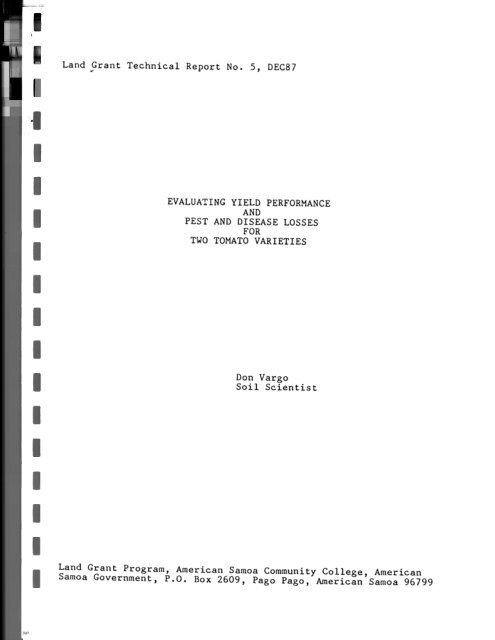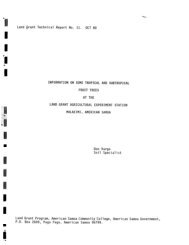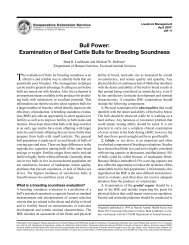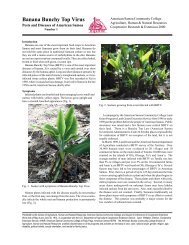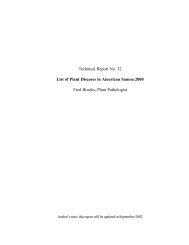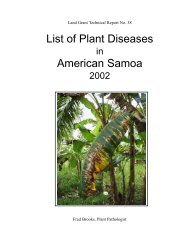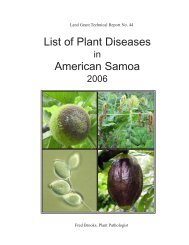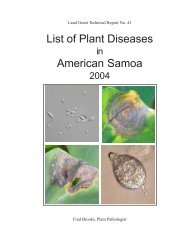Create successful ePaper yourself
Turn your PDF publications into a flip-book with our unique Google optimized e-Paper software.
Land Grant Technical Report <strong>No</strong>.5, DEC87<br />
"'<br />
EVALUA~ING YIELD PERFORMANCE<br />
AND<br />
PEST AND DISEASE LOSSES<br />
FOR<br />
TWO TOMATO VARIETIES<br />
Don Vargo<br />
Soil Sc.ientist<br />
Land Grant Program, American Samoa Community College, American<br />
Samoa Government, P.O. Box 2609, Pago Pago, American Samoa 96799
I<br />
-<br />
ABSTRACT<br />
I<br />
I<br />
I<br />
I<br />
I<br />
Locally grown tomatoes are expensive<br />
in American Samoa, primarily because<br />
pests and diseases destroy much <strong>of</strong><br />
the crop. The purpose <strong>of</strong> this study<br />
is to determine the extent <strong>of</strong> these<br />
losses, and to evaluate yield performances<br />
using two tomato varieties<br />
from the <strong>University</strong> <strong>of</strong> <strong>Hawaii</strong>--BWN-<br />
21 and Kewalo--that have gained moderate<br />
success in the Territory. New<br />
crop protection devices and production<br />
practices, based on the results<br />
<strong>of</strong> this study, may lessen the risk<br />
<strong>of</strong> growing tomatoes commercially in<br />
the Territory.
I<br />
I<br />
TABLE<br />
OF CONTENTS<br />
ABSTRACT.<br />
i<br />
TABLE OF CONTENTS i i<br />
INTRODUCTION. 1<br />
METHODS AND MATERIALS 1<br />
RESULTS.<br />
DISCUSSION<br />
3<br />
4<br />
ACKNOWLEDGEMENTS. 5<br />
REFERENCES. 5<br />
FIGURE 1 6<br />
FIGURE 2 7<br />
FIGURE 3 8<br />
FIGURE 4 9<br />
FIGURE 5 10<br />
TABLE 1<br />
TABLE 2<br />
11<br />
13<br />
I<br />
I<br />
I<br />
ii
In American<br />
Samoa,<br />
tomatoes are generally sold 2 to 4 times<br />
above the United States market price, and supply is <strong>of</strong>ten sporadiCe<br />
This is because growing tomatoes commercially in the Territory<br />
is risky. Wilt diseases, primarily bacterial wilt, Pseudomonas<br />
solanacearum, and an abundance <strong>of</strong> year-round pests, chiefly<br />
birds and the fruit-piercing moth, Othreis fullonica, plague the<br />
plant and its fruit. Air-shipping charges make imported f~uit,<br />
usually <strong>of</strong> inferior quality, comparatively. priced with locally<br />
grown tomatoes.<br />
Consequently, needs exist for increasing the<br />
marketable yield and ensuring a steady supply <strong>of</strong> locally grown<br />
Although pests and diseases are the major constraints to tomato<br />
production, losses have not been assessed quantitatively.<br />
The purpose <strong>of</strong> this study is to document the extent <strong>of</strong> losses due<br />
I to these agents, and to evaluate two tomato varieties for their<br />
bacterial wilt tolerance and yield performance.<br />
METHODS AND MATERIALS<br />
Kewalo and BWN-21 are, respectively, a bush variety and a<br />
vine-type hybrid tomato that are nematode resistant and bacterial<br />
wilt tolerant, and are recommcnded for Western Samoa, (1,2).<br />
For each variety two seeds were planted 30 April 1987 in<br />
cells containing 160 cm3 <strong>of</strong> moist Jiffy MixTM Cells were placed<br />
outside in partial sun, protected from rain and watered as need-<br />
I ed. The mean daily temperature was 27°C. After two weeks the<br />
germination rates were determined to be 92% and 96%, respective-<br />
tomatoes.<br />
1
June. planned,<br />
I<br />
leaf<br />
{Table 1).<br />
stage,<br />
I<br />
I<br />
I<br />
I<br />
vation<br />
A split-plot experimental design with 6 replications was<br />
using insect pest treatment as main plots and tomato<br />
previously planted with taro, Colocasia esculenta, was selected<br />
as the study site. Holes 1 ft (0.3 m) in diameter and 1 ft deep<br />
were dug 4 ft (1 m) apart. About 0.7 L <strong>of</strong> moist Jiffy-Mix conadded<br />
to each hole. A mixture <strong>of</strong> 12 parts sieved soil, 4 parts<br />
PerliteTM , 2 parts chicken manure and 1 part powdered limestone<br />
I was added to fill the holes. The filled holes were thoroughly<br />
I<br />
watered and the seedlings transplanted 5 days later.<br />
Two weeks<br />
bacterial will. These plants were removed and destroyed. Eventually,<br />
10 <strong>of</strong> 48 plants succumbed to this disease,<br />
(Figure 1)<br />
I<br />
through 27 June in a'4-pole tepee configuration.<br />
not pruned.<br />
The plants<br />
were<br />
* All metric conversions are approximations.<br />
I
I<br />
ance. declined,<br />
0<br />
~ pests,<br />
I (Figure 1).<br />
I<br />
I<br />
I<br />
minimize losses due to birds and rodents.<br />
.<br />
ing was generally done on alternate days.<br />
Consequently,<br />
harvest-<br />
Fruits were wei'ghed<br />
r -<br />
I<br />
I<br />
I<br />
I<br />
I<br />
I<br />
I<br />
I<br />
RESULTS<br />
(Figure 2).<br />
the normal amount, <strong>of</strong> rain fell,<br />
spectively),<br />
Yields for<br />
(Figure 3). BWN-21 out yielded<br />
(Table 2). Frequency dis-<br />
I<br />
(Figure 4). Average
high, ties.<br />
,<br />
~ Damage caused by birds and rodents accounted for over 10% <strong>of</strong><br />
fruit losses, (Figure 5). BWN-21 appeared more vulnerable to<br />
attack by fruit-eating caterpillars, including the fruit-piercing<br />
moth, and the African snail, Achatina fulica. The latter may<br />
dishave<br />
preferred BWN-21 be~ause <strong>of</strong> its denser foliage.<br />
Pests,<br />
eases and blemishes accounted for losses <strong>of</strong> 32% and 24% <strong>of</strong> marketable<br />
fruit for BWN-21 and Kewalo, respectively.<br />
DISCUSSION<br />
BWN-21 and Kewalo are indeterminate tomato varieties with<br />
globe-shaped fruit that require about 70 days from transplant to<br />
harvest.<br />
Though both varieties are described as bacterial wilt<br />
tolerant, both succumbed to this disease with losses <strong>of</strong> 25% and<br />
17%, respectively. Fruit losses due to pests and disease are<br />
with vertebrate pests responsible for much <strong>of</strong> the damage<br />
In order to minimize losses, plants may be grown inside wire<br />
~ages ~overed with netting to ex~lude birds.<br />
A band several<br />
ches high along the bottom <strong>of</strong> the cage would also bar snails.<br />
This will be attempted in a future study.<br />
Alternatively,<br />
in-<br />
swit~h-<br />
ing to a determinate tomato variety and planting at 2 to 3 week<br />
intervals might obviate use <strong>of</strong> a barrier.<br />
{<br />
By inundating pests<br />
briefly with ripening fruit, losses might be limited by depriving<br />
pests <strong>of</strong> a continuous source <strong>of</strong> food.<br />
This strategy is used, in<br />
part, by home gardeners who prefer to use che~~y tomato varie-<br />
Several deter~inate tomato varieties will be tested in a<br />
future<br />
study.
I<br />
-<br />
-'<br />
ACKNOWLEDGEMENTS<br />
I wish to thank Mr. Lloyd Ali and Mr. Malala Misa for their<br />
I<br />
available through Hatch Grant Project Number SAM-OO2.<br />
.<br />
excellent technical assistance.<br />
Funds for this study were made<br />
REFERENCES<br />
I<br />
I<br />
I<br />
I<br />
I<br />
BWN-21 and Kewalo tomato varieties are available from the<br />
<strong>University</strong> <strong>of</strong> <strong>Hawaii</strong>, College <strong>of</strong> Tropical Agriculture and<br />
Resources, Seed Program, Department <strong>of</strong> Horticulture, St.<br />
John Plant Science Building, 3190 Maile Way, Room 112, Honolulu,<br />
<strong>Hawaii</strong> 96822.<br />
Finlay, F., Lomekina Pahulu, D.A. Slade, M. T<strong>of</strong>inga and J.E<br />
Wilson. 1983. Vegetable Cultivars Recommended for Western<br />
Samoa, Alafua Agric. Bull. 8(3), p 69.<br />
I<br />
I<br />
.I 1. 2.<br />
I<br />
I<br />
TMReg~stered Trade Mark produ~ts appearing in this report are listed<br />
for the reader's information and do not constitute an endorsement<br />
by the Land Grant Program.
I<br />
I<br />
yo<br />
1 28FT -I<br />
r4FT~<br />
~ x<br />
.-I<br />
& 0 (~~l=~~~~~r~) !, r;<br />
5<br />
I ~<br />
,L C~2~~~~~~:~) c~)- 3_~)<br />
X<br />
-Ḇ<br />
~<br />
&<br />
B<br />
..<br />
& &<br />
I'-<br />
0<br />
x<br />
0 9<br />
N<br />
I 0 &-\ &. £<br />
c,-,<br />
K<br />
~<br />
-<br />
B<br />
0~ x<br />
~~<br />
-<br />
-,<br />
k'<br />
-<br />
13<br />
B<br />
'-<br />
& & @~ x<br />
0<br />
~~<br />
~<br />
& K.<br />
-<br />
Ḇ<br />
17<br />
Figure 1. Field layout <strong>of</strong> tomato variety trial. A 20 ft by 28 ft<br />
I<br />
field was originally laid out on a split-plot design,<br />
but later modified for a randomized ~omplete blo~k desi~n<br />
with 17 blo~ks with one Kewalo (K) and one BWN-21<br />
I<br />
(B) plant per blo~k. Plants were 4 ft apart and staked<br />
on a 4-pole tepee trellis, as indi~ated by ~rosses.<br />
Plants represented by triangles were atta~ked by ba~terial<br />
wilt disea~~.<br />
I<br />
I<br />
I<br />
I<br />
I<br />
~<br />
I<br />
6
,<br />
~<br />
~<br />
c<br />
~<br />
.-<br />
u<br />
~<br />
:Ż<br />
~ 80 10 ~ ~<br />
Q.A.T.<br />
I<br />
I<br />
0..<br />
u<br />
a.o-<br />
~ ~~ 1A-<br />
I<br />
I<br />
I<br />
I<br />
I<br />
I<br />
I<br />
..<br />
- ... IN<br />
~ - ,<br />
--<br />
Figure 2. Yields and losses for tomato varieties. Kewalo and<br />
" BWN-21 tomato varieties were harvested between 69 and r<br />
121 days after transplanting, (D.A.T.), and their;<br />
yields (.) and loss-es (0) recorded.<br />
7
I<br />
_8 ",.. ..'<br />
I<br />
I<br />
I<br />
I<br />
I
I<br />
I<br />
I<br />
I<br />
Figure 4. Frequency distribution <strong>of</strong> individual tomato weights.<br />
The 392 Kewalo and 400 BWN-21 tomatoes harvested during<br />
the study were grouped into 10 cells Qf 25 gram increments,<br />
i.e., cell 1 contained tomatoes weighing between<br />
1 to 25 g; cell 2 contained tomatoes weighing between<br />
26 to 50 g; etc. Both distributiops are skewed right<br />
<strong>of</strong> norma~ toward heavier tomato weights.<br />
I 9
~<br />
I ,<br />
I<br />
bird & rodent<br />
caterpillar<br />
fruit rot<br />
blemish<br />
snail<br />
cracking<br />
I<br />
I<br />
Figure <strong>5.</strong> Fruit losses due to pests, disease and blemishes. Percent<br />
losses ~re based on weight. Total losses for Kewalo<br />
and BWN-21 varieties are 24% and 32%, respectively.<br />
I<br />
I<br />
. I.<br />
10
I<br />
I<br />
I<br />
.<br />
Table 1, continued<br />
p<br />
X BWN-21 Kewalo<br />
0 0/16 0/16<br />
1<br />
2<br />
2/16<br />
,14/16<br />
3/16<br />
13/16<br />
I<br />
I<br />
p<br />
X BWN-21 Kewalo<br />
0 1.0000 1.0000<br />
1 0.9330 0.8669<br />
2 0.9354 0.8770<br />
0.956 0.915<br />
I<br />
I<br />
I<br />
I<br />
I<br />
I<br />
.<br />
12<br />
Averages:
Source <strong>of</strong> Variation df Sum <strong>of</strong> Squares Mean Squares F-Value<br />
Total<br />
.Blocks<br />
Varieties<br />
Error<br />
33<br />
16<br />
1<br />
16<br />
83 688 933.5<br />
44 846 46<strong>5.</strong>5<br />
2 255 957.7<br />
36 586 510.3<br />
2 255 957.7<br />
2 286 656.9<br />
O.99t<br />
t<strong>No</strong>t<br />
significant<br />
The accumulated yields, in grams, for the above AN OVA are:<br />
. 12<br />
I<br />
I<br />
I<br />
I<br />
I<br />
I<br />
I<br />
I<br />
3<br />
4<br />
5<br />
6<br />
7<br />
8<br />
9<br />
l' 0<br />
11<br />
1 2<br />
1 3<br />
1 4<br />
1 5<br />
1 6<br />
1 7<br />
2 470<br />
3 696<br />
1 005<br />
2 114<br />
4 035<br />
1 611<br />
1 192<br />
966<br />
1 319<br />
3 169<br />
635<br />
1 579<br />
1 914<br />
661<br />
1 626<br />
1 405<br />
307<br />
29 704<br />
I 13<br />
1 564<br />
2 387<br />
1 088<br />
3 289<br />
1 763<br />
1 467<br />
3 400<br />
858<br />
1 563<br />
1 598<br />
2 245<br />
7 041<br />
7 113<br />
1 010<br />
581<br />
810<br />
685<br />
38 462


